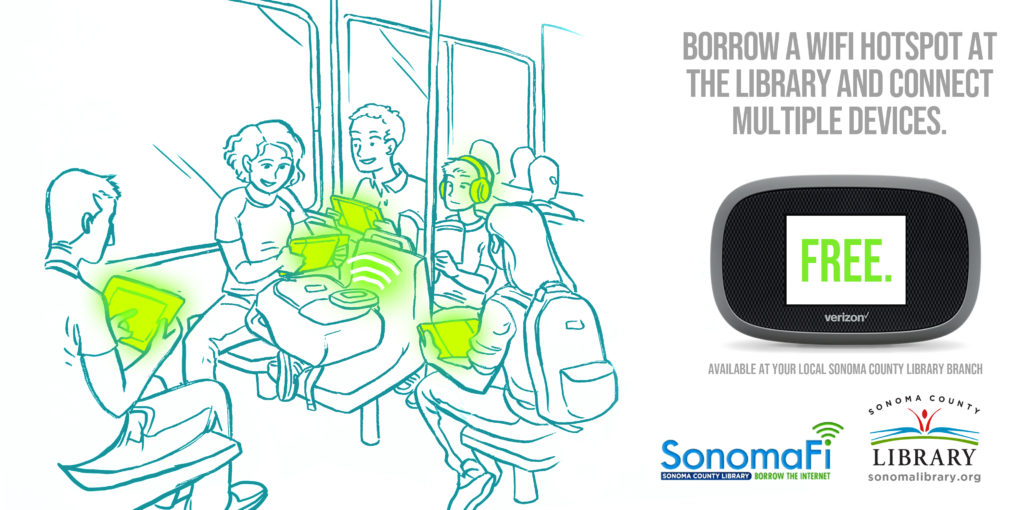Sonoma County Library Closing the Digital Divide by Lending WiFi
By Ray Holley, Community Relations Manager, Sonoma County Library

For centuries, libraries focused on gathering and storing information to share with the public. As the modern idea of a library developed throughout the 20th Century, the emphasis shifted to making that information widely and freely available. In the 21st Century, the delivery systems are diversifying, but the concept remains that equal and equitable access to information is necessary to a free society. Technology – and WiFi – plays an increasingly important role.
In April 2019, the Sonoma County Library began lending WiFi hotspots to its patrons. Dubbed “SonomaFi” and marketed as “Borrow the Internet” and “SonomaFi your Life,” the 500 hotspots are a way for library patrons to take the Internet camping and traveling, work from coffee shops and create a convenient connection wherever they go.
Social Equity
“There’s another reason to lend the Internet,” said Library Director Ann Hammond. “Social equity. Sonoma County is filled with contrasts. Its natural beauty and mild weather attracts people from all over the world, yet income disparity is rampant. In many public schools, almost half the students qualify for free or reduced-cost lunches.”
Hammond points out that working families in Sonoma County struggle, and often make heartbreaking choices between dental care and rent, or car repairs and healthy food. Broadband is plentiful in the county, but it’s expensive, and a smartphone may be the only computer in a household.
WiFi Embedded in Library Services
Even before the hotspot program, the library offered free high speed WiFi and public computers in all branches. At a time when good jobs, student financial aid and even routine schoolwork and communication require reliable computer access, the library is filling a niche. At the library’s remote rural stations, residents even park in library parking lots to connect to WiFi. So far in 2019, Sonoma County Library has averaged 54,915 separate WiFi sessions a month in its branches.
Loaning WiFi became the next step in this effort to provide equal–and equitable–access to information. The program started slowly, but is now exceeding expectations, with an 85 percent usage rate and branches running out of hotspots. More hotspots have been ordered, and will be placed in the branches with the highest demand.
Direct Impact
As the program grows, stories from patrons are coming in. Donna Williamson and her husband lost their home in the devastating fires that swept Sonoma County in October 2017. “Out of 106 homes in our Foothills community, only six survived,” Williamson said. The utilities in her area were destroyed. “At first, I borrowed a hotspot so that I could be in touch with people while I waited for contractors at the site,” she said, “but it turned out to be much more than that.”
Using connection speed data obtained from the library hotspot, Williamson was able to compile information that is helping her neighborhood apply for a grant to help restore its infrastructure. “I’m really happy,” she said. “It’s nice to see that libraries are doing more than just books.”
Staff Collaboration
The hotspot lending program at Sonoma County Library was led by the library’s Information Technology Manager, Vicki Terbovich, who assembled a team of staff from across the system to plan and launch the program.
Terbovich researched best practices from other library systems and settled on Verizon, which offers the most complete coverage map for Sonoma County. Due to the size of the order and Verizon’s eagerness to work with the library, the library only paid sales tax on the initial order of 500 hotspots. She also contracted with Peak-Ryzek to implement a managed mobility service that allows remote shut-off for late devices, as well as custom configurations.
The project was a significant technical achievement for the library, but the human impact has made a lasting impression. “The SonomaFi project is so gratifying,” said Terbovich. “Not only is this a great service and a lot of fun to implement, but we’re changing people’s lives by giving them access to the Internet.”
Changing Lives
To demonstrate Terbovich’s point, this summer, the library received the following message from a library patron (name withheld at her request):
“I would like to extend my deepest thanks and gratitude towards whoever supported the idea of the sonoma-fi devices. Being a homeless individual is tough enough, but when coupled with the constant need for internet it’s frightening. On top of that, if you are like me and have extreme anti-social anxiety, it becomes terrifying. Thanks to the Sonoma County Library along with others, I am able to find work and attend school anywhere, as long as I am back at the library within the 14-day renewal time period. I have a great job at a glass shop and I am learning a computer language called Linux with the help of the library books I borrow and the internet they allow me to use both inside and outside the city limits. I feel like I am going on and on, so I will stop here, but I could go at least 3 pages about the help the people at the library have afforded me, so I thank you very much.”
For more information about SonomaFi, visit sonomalibrary.org/sonomafi
Ray Holley is the Community Relations Manager for the Sonoma County Library.
SonomaFi at a glance
Time to plan and implement – 6 months
Verizon WiFi hotspots available to loan – 500 (200 more going in service soon)
Hotspots checked out at any one time – 85 percent (more than any other library asset)
Cost to implement – $400,000 (first year, includes start up)
If you liked this post, you can follow us on Twitter and Facebook for more updates.
